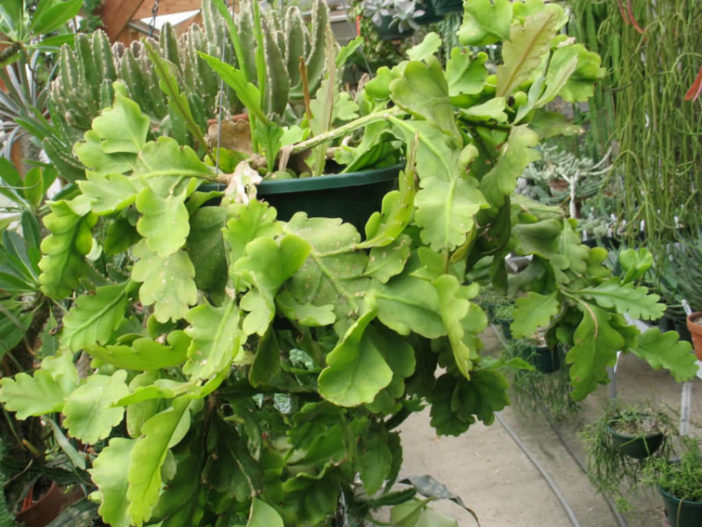Scientific Name
Rhipsalis oblonga Loefgr.
Synonym(s)
Rhipsalis crispimarginata
Scientific Classification
Family: Cactaceae
Subfamily: Cactoideae
Tribe: Rhipsalideae
Genus: Rhipsalis
Origin
Rhipsalis oblonga is endemic to Brazil. It occurs in Rio de Janeiro and northern Sao Paulo, growing as an epiphyte in coastal or montane forests.
Description
Rhipsalis oblonga is a shrubby cactus with segmented, semi-erect to pendent, olive green or light green stems that grow up to 8.2 feet (2.5 m) long. The main stems are cylindrical at the base, becoming flattened above, branching apical or lateral, up to 8 inches (20 cm) long, and up to 0.4 inches (2 cm) across. The stem segments have serrated margins and large areoles. They are up to 6 inches (15 cm) long and 2.4 inches (6 cm) wide.
The flowers are yellowish-white and appear along the sides of the branches, solitary at the areoles from spring to fall. The fruits are greenish translucent to nearly white at maturity, spherical, and up to 0.3 inches (0.7 cm) in diameter.

Hardiness
USDA hardiness zones 10a to 11b: from 30 °F (−1.1 °C) to 50 °F (+10 °C).
How to Grow and Care
Rhipsalis do not thrive in direct sunlight. Exposure to the afternoon sun can burn the leaves, turn them yellow, or lead to spotting. However, they will not bloom without sufficient sunlight, and their growth can be stunted. Therefore, these cacti do best with morning sun and full shade in the afternoon.
As Rhipsalis is commonly grown indoors, care must be given to the placement of the plants. They should be kept at least 20 inches (50 cm) from windows that receive midday or afternoon sun. The glass in the windows can multiply the heat from the sun's rays, causing sunburned leaves. Keep in mind that in its native environment, Rhipsalis is accustomed to receiving light filtered through dense, overhanging tree branches. Picturing this environment can help you adjust your lighting accordingly.
Rhipsalis is not a drought-resistant plant, so regular watering is essential. Overwatering, however, can cause weak stems and rotted roots. Using a watering can help you measure the amount of water you are providing. The size of the pot compared to the size of the plant, the humidity levels in the home, and the type of potting soil used can all affect the watering frequency.
Learn more at How to Grow and Care for Rhipsalis.
Links
- Back to genus Rhipsalis
- Succupedia: Browse succulents by Scientific Name, Common Name, Genus, Family, USDA Hardiness Zone, Origin, or cacti by Genus
Photo Gallery
Click on a photo to see a larger version.



